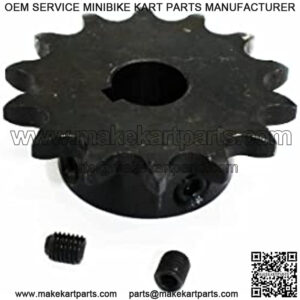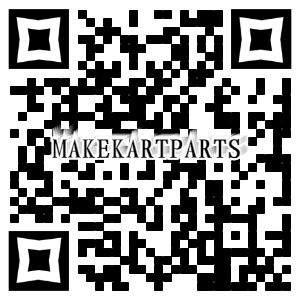Sprockets are rotating toothed wheels which are used to transmit power or convey materials by engaging with roller or conveyor chains. Key specifications include the intended application, material, number of teeth, and pitch as well as the physical dimensions as required. Sprockets are used primarily in chain driven systems to transmit power or rotation to other shafts. An example is a bicycle sprocket that transmits rotation from the pedals to the wheel. Sprockets may also be used to convey material from place-to-place as in the case of overhead conveyors. Sprockets come in a variety of tooth configurations depending on the intended application and chain type.
Sprockets used strictly for power transmission are matched to the corresponding standard ANSI chain pitches. Typical applications include roller chains and silent chains, which are used in power transmission applications ranging from motorcycles to conveyor drives. Sprockets are generally used in pairs often with differing tooth counts to provide speed reduction in a manner similar to gears. Unlike gears, sprocket teeth do not mesh with each other but rather with the rollers on transmission chain and are hence able to bridge greater distances than any pair of mating gears could reasonably span. Sprockets are ordinarily manufactured in metal but they can be made in other materials such as plastic. They can be purchased hub-less or in any number of hub designs for securing to drive shafts. Idler sprockets are used as intermediate carriers that do not transmit power. Sprockets can be selected by pitch and number of teeth.Power Transmission Roller Chain
Engineered Chain
Sprockets for engineered chains such as those used for conveying are similar to toothed sprockets used for power transmission but often have wider tooth spacings to accommodate the longer pitches typically found in engineered chains. Engineered chain sprockets can be quite large when compared with power transmission sprockets and are usually identified as being either the center-plate variety or the spoked-arm type. Center plate designs are typical in the smaller engineered chain sprockets while spoked-arm types are prevalent in larger diameters where the mass of the sprocket is an important consideration.
Applications and Industries
Power transmission sprockets are used anywhere gears might be required but where the distance between shafts centers makes them impractical. Automotive engines use chains and sprockets to drive and synchronize camshafts with crankshafts. Often, these are multiple sprockets driving double- or triple-wide roller chainsets. Motorcycles use chains and sprockets for primary and final drives. Chains operate well in dirty environments such as on motorcycles because the individual rollers on the chain will retain lubricant and operate successfully under open conditions. Gears function better in housed environments with lubricant sumps, etc. Unlike gears, chains can stretch with use and require occasional adjustment of center distances or the use of chain tensioners or idler sprockets to pull in any slack. Chains are also dependent on proper alignment and tension during their initial installations and most chain manufacturers give detailed advice regarding these parameters. Chains tend to be noisier than gears although inverted-tooth, or so-called silent chains, alleviate this concern somewhat. They also have lower speed capabilities than gears exhibit.
Engineered chain sprockets tend to be beefier than their power transmission counterparts owing to the additional loads put on the chains as conveyors, etc. Sometimes these chains are called agricultural chains, lumber chains, mining chains, etc. and they are often fitted with attachments at the links which the sprockets sometimes must accommodate.
Some engineered chain sprockets are fitted with bolt-on tooth sectors which makes it possible to replace worn teeth without disassembling the conveyor chains and removing the sprockets from their drive shafts.
Considerations
Sprockets are identified by pitch and pitch circle. Pitch is the chordal distance between chain links and is usually given in inches or millimeters. Pitch circle is the circle inscribed by the centers of the chain pins where they lay in the sprocket teeth. Sprockets are often selected by pitch and by the number of teeth. As with gears, speed ratios are determined by the number of teeth on the drive sprocket and the number of teeth on the driven sprocket. For example, a 50 tooth drive sprocket connected by a chain to a 100 tooth driven sprocket would produce a 2:1 speed reduction, i.e. 1800 rpm on the drive side would produce 900 rpm on the driven sprocket.
Standard ANSI chains and sprockets are selected by coded standard sizes, the first digit number of which represents the pitch in 1/8 inch increments. For example, #40 chain has a pitch of 4/8 or 1/2 inch. The second number of the code denotes special chain features. In larger sizes, the code becomes a three digit number but the first two digits still denote the pitch in 1/8 inch increments.
Conveyor chain sprockets and engineered chain sprockets are also commonly designated by pitch and number of teeth but often the pitch is a direct numerical measure owing to the larger pitches common with these elements.
Some conveyor chain sprockets employ a hunting tooth arrangement wherein the sprocket contains extra half-pitch teeth and an odd number of total teeth which distributes the wear among two sets of teeth for increased longevity.
About chain sprocket
“bike chain sprocket”
“chain sprocket kit”
“roller chain sprocket”
“chain sprocket material”
“25 chain sprocket”

